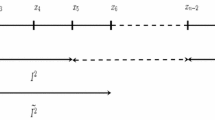Abstract
In this paper, a variationally consistent contact formulation is considered and we provide an abstract framework for the a priori error analysis in the special case of frictionless contact and small deformations. Special emphasis is put on quadratic mortar finite element methods. It is shown that under quite weak assumptions on the Lagrange multiplier space \({\mathcal{O} (h^{t-1}), 2 < t < \frac52}\) , a priori results in the H 1-norm for the error in the displacement and in the H −1/2-norm for the error in the surface traction can be established provided that the solution is regular enough. We discuss several choices of Lagrange multipliers ranging from the standard lowest order conforming finite elements to locally defined biorthogonal basis functions. The crucial property for the analysis is that the basis functions have a local positive mean value. Numerical results are exemplarily presented for one particular choice of biorthogonal (i.e. dual) basis functions and also comprise the case of finite deformation contact.
Similar content being viewed by others
References
Alart P, Curnier A (1991) A mixed formulation for frictional contact problems prone to Newton like solution methods. Comput Methods Appl Mech Eng 92: 353–375
Belhachmi Z, Ben Belgacem F (2003) Quadratic finite element approximation of the Signorini problem. Math Comput 72: 83–104
Chen Z, Nochetto R (2000) Residual type a posteriori error estimates for elliptic obstacle problems. Numer Math 84: 527–548
Eck C, Jarusek J, Krbec M (2005) Unilateral contact problems: variational methods and existence theorems. Chapman & Hall/CRC, Boca Raton
Fischer-Cripps A (2000) Introduction to contact mechanics, mechanical engineering series. Springer, New York
Flemisch B, Melenk J, Wohlmuth BI (2005) Mortar methods with curved interfaces. Appl Numer Math 54: 339–361
Gitterle M, Popp A, Gee MW, Wall WA (2010) Finite deformation frictional mortar contact using a semi-smooth Newton method with consistent linearization. Int J Numer Methods Eng 84: 543–571
Hager C, Wohlmuth BI (2010) Semismooth Newton methods for variational problems with inequality constraints. GAMM Mitteilungen 33: 8–24
Han W, Sofonea M (2002) Quasistatic contact problems in viscoelasticity and viscoplasticity, Studies in Advanced Mathematics, American Mathematical Society. International Press, Somerville
Hauret P, Le Tallec P (2007) A discontinuous stabilized mortar method for general 3d elastic problems. Comput Methods Appl Mech Eng 196: 4881–4900
Hertz H (1882) Über die Berührung fester elastischer Körper. J Reine Angew Math 92: 156–171
Hild P, Laborde P (2002) Quadratic finite element methods for unilateral contact problems. Appl Numer Math 41: 410–421
Hüeber S, Mair M, Wohlmuth BI (2005) A priori error estimates and an inexact primal-dual active set strategy for linear and quadratic finite elements applied to multibody contact problems. Appl Numer Math 54: 555–576
Hüeber S, Stadler G, Wohlmuth BI (2008) A primal-dual active set algorithm for three-dimensional contact problems with Coulomb friction. SIAM J Sci Comput 30: 572–596
Hüeber S, Wohlmuth BI (2005) A primal-dual active set strategy for non-linear multibody contact problems. Comput Methods Appl Mech Eng 194: 3147–3166
Johnson K (1985) Contact mechanics. Cambridge University Press, Cambridge
Kikuchi N, Oden JT (1988) Contact problems in elasticity: a study of variational inequalities and finite element methods. Society for Industrial and Applied Mathematics (SIAM), Philadelphia
Laursen TA (2002) Computational contact and impact mechanics. Springer, Berlin
Li J, Melenk J, Wohlmuth BI, Zou J (2010) Optimal a priori estimates for higher order finite elements for elliptic interface problems. Appl Numer Math 60: 19–37
Moussaoui M, Khodja K (1992) Régularité des solutions d’un problème mêlé Dirichlet–Signorini dans un domaine polygonal plan. Commun Partial Differ Equ 17: 805–826
Nochetto R, Wahlbin L (2002) Positivity preserving finite element approximation. Math Comput 71: 1405–1419
Popp A, Gee MW, Wall WA (2009) A finite deformation mortar contact formulation using a primal-dual active set strategy. Int J Numer Methods Eng 79: 1354–1391
Popp A, Gitterle M, Gee MW, Wall WA (2010) A dual mortar approach for 3D finite deformation contact with consistent linearization. Int J Numer Methods Eng 83: 1428–1465
Popp A, Wohlmuth BI, Gee MW, Wall WA (2011) Dual quadratic mortar finite element methods for 3D finite deformation contact. Tech. report, Technische Universität München
Puso MA, Laursen TA (2002) A 3D contact smoothing method using Gregory patches. Int J Numer Methods Eng 54: 1161–1194
Puso MA, Laursen TA (2004) A mortar segment-to-segment contact method for large deformation solid mechanics. Comput Methods Appl Mech Eng 193: 601–629
Puso MA, Laursen TA (2004) A mortar segment-to-segment frictional contact method for large deformations. Comput Methods Appl Mech Eng 193: 4891–4913
Puso MA, Laursen TA, Solberg J (2008) A segment-to-segment mortar contact method for quadratic elements and large deformations. Comput Methods Appl Mech Eng 197: 555–566
Timoshenko SP, Goodier JN (1970) Theory of elasticity. McGraw-Hill, New York
Wall WA, Gee MW (2010) Baci—a multiphysics simulation environment. Tech. report, Technische Universität München
Wohlmuth BI (2011) Variationally consistent discretization schemes and numerical algorithms for contact problems. Acta Numerica, pp 569–734
Wriggers P (2002) Computational contact mechanics. Wiley, New York
Wriggers, P, Nackenhorst, U (eds) (2007) Computational methods in contact mechanics, vol 3 of IUTAM Bookseries. Springer, Berlin
Author information
Authors and Affiliations
Corresponding author
Rights and permissions
About this article
Cite this article
Wohlmuth, B.I., Popp, A., Gee, M.W. et al. An abstract framework for a priori estimates for contact problems in 3D with quadratic finite elements. Comput Mech 49, 735–747 (2012). https://doi.org/10.1007/s00466-012-0704-z
Received:
Accepted:
Published:
Issue Date:
DOI: https://doi.org/10.1007/s00466-012-0704-z




